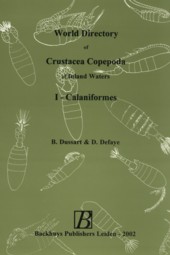

The first edition
of this directory was published almost 20 years ago. Since then, numerous new
species have been described, some genera and families have been revised, and
new synonymies and updated keys have been published. These changes have all
been incorporated into this second, amended, English edition of ‘Répertoire
mondial des Crustacés Copépodes des eaux intérieures,
tome 1: Calanoida’.
The contents are organized as in the previous edition. The references cited
in the taxonomic part are given in alphabetical order, and the abbreviations
of the references follow the ISO-4 standards (ISDS, 1985 and following years).
The scientific index includes the synonyms in Roman characters, which allows
the reader to follow the trail of any citation to its present valid name. For
each genus, the typespecies is given first and is marked by an asterisk; the
order followed for the other species is chronological. For each species, a synonymy
is given, followed by other specifying citations or references on morphology,
physiology, biology, or ecology of the species; distribution is also given.
The 8 families treated are:
Aetideidae, Clausocalanidae, Centropagidae, Pseudodiaptomidae, Acartiidae, Sulcanidae,
Temoridae, and Diaptomidae (the most widely distributed family in inland waters).
All species described from 1898 until 2000 are included. This is a definite
reference work for all those involved in copepod research.
"French workers Bernard Dussart and Danielle Defaye have done a great
service to limnological copepodologists by compiling this very useful directory.They
have succeeded in bringing together a huge amount of widely scattered literature
and have produced order out of chaos.This English translation, an amended
and enlarged version of their 1983 French original, will bring this work
before a wider audience, and the accuracy has been greatly improved. This
monograph is not just for the taxonomist, for it includes references to general
biology, ecology and physiology. Also, coverage is not restricted to fresh
waters since euryhaline species, characteristic of estuaries and lagoons,
in such families as the Pseudodiaptomidae and Acartiidae, are included. There
are some 1,800 references. I strongly recommend the purchase of this volume
to all serious students of copepoda occurring in inland waters and estuaries.
Libraries servicing limnological interests should also have a copy for reference."
Ian A.E. Bayly